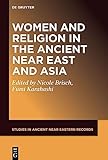Women and Religion in the Ancient Near East and Asia / ed. by Nicole Maria Brisch, Fumi Karahashi.
Material type: TextSeries: Studies in Ancient Near Eastern Records (SANER) ; 30Publisher: Berlin ; Boston : De Gruyter, [2023]Copyright date: ©2023Description: 1 online resource (300 p.)Content type:
TextSeries: Studies in Ancient Near Eastern Records (SANER) ; 30Publisher: Berlin ; Boston : De Gruyter, [2023]Copyright date: ©2023Description: 1 online resource (300 p.)Content type: - 9781501518614
- 9781501514531
- 9781501514821
- online - DeGruyter
- Issued also in print.
| Item type | Current library | Call number | URL | Status | Notes | Barcode | |
|---|---|---|---|---|---|---|---|
 eBook
eBook
|
Biblioteca "Angelicum" Pont. Univ. S.Tommaso d'Aquino Nuvola online | online - DeGruyter (Browse shelf(Opens below)) | Online access | Not for loan (Accesso limitato) | Accesso per gli utenti autorizzati / Access for authorized users | (dgr)9781501514821 |
Frontmatter -- Foreword and Acknowledgements -- Contents -- Introduction -- Women’s History and Gender History in Japan -- Part I: Businesswomen, Empresses, and Royal Women -- Socio-Economic Aspects and Agency of Female Maš-da-ri-a Contributors in Presargonic Lagash -- The Role of Women in Assyrian Foreign Policy -- Women Involved in Daily Management in Achaemenid Babylonia: The Cases of Rē’indu and Andiya -- Wu Zetian’s Buddhist Policy: A New Perspective -- Part II: Priestesses -- The Office and Responsibilities of the En Priestess of Nanna: Evidence from Votive Inscriptions and Documentary Texts -- High Priestesses in Old Babylonian Nippur: The NIN and NIN-dingir Priestesses of Ninurta -- Hittite Royal Ideology and the Uniqueness of the Priestess Titled NIN.DINGIR -- The Roles of Women in the Practice of Ancient Mesopotamian Divination -- Part III: Goddesses -- Enheduana’s Invocations: Form and Force -- On Language, Gender, Sex, and Style in the Sumerian Language -- Venomous Scorpions and Venerable Women: The Relationship Between Scorpions, the Goddess Išḫara, and Queens in the Neo-Assyrian Period -- The Networks of Ashtart-Aphrodite and the Archaic Mediterranean Koiné -- The Lioness Goddess Statuary from the Rock-Cut Chambers at Northwest Saqqara and Their Cult in Middle Kingdom Egypt -- Index
restricted access online access with authorization star
http://purl.org/coar/access_right/c_16ec
The recent years have seen an upswing in studies of women in the ancient Near East and related areas. This volume, which is the result of a Danish-Japanese collaboration, seeks to highlight women as actors within the sphere of the religious. In ancient Mesopotamia and other ancient civilizations, religious beliefs and practices permeated all aspects of society, and for this reason it is not possible to completely dissociate religion from politics, economy, or literature. Thus, the goal is to shift the perspective by highlighting the different ways in which the agency of women can be traced in the historical (and archaeological) record. This perspectival shift can be seen in studies of elite women, who actively contributed to (religious) gift-giving or participated in temple economies, or through showing the limits of elite women’s agency in relation to diplomatic marriages. Additionally, several contributions examine the roles of women as religious officials and the language, worship, or invocation of goddesses. This volume does not aim at completeness but seeks to highlight points for further research and new perspectives.
Issued also in print.
Mode of access: Internet via World Wide Web.
In English.
Description based on online resource; title from PDF title page (publisher's Web site, viewed 06. Mrz 2024)


